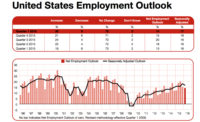The outlook remains positive for landscape architecture firms, according to the American Society of Landscape Architects’ second quarter 2014 “Business Quarterly” survey. The survey revealed a marked rise in billable hours and inquiries for new work. Hiring plans rose slightly from the last quarter.
More than 84% of respondents reported stable to significantly higher inquiries for new work, an increase from 80.2% last quarter. In addition, 82.42% indicated stable to significantly higher billable hours, compared to 72.2% last quarter.
Year to year, 85.17% noted stable to significantly higher second-quarter inquiries for new work, higher than the second quarter of 2013 (83.4%). Additionally, 81.32% indicated second-quarter billable hours remained about the same or were higher, a jump from the second quarter of 2013 (76%).
Of all firms with two or more employees, more than half (51.75%) said they planned to hire in the third quarter of 2014, slightly more than the previous quarter (49.4%). Some 62.5% of firms with 50-99 employees said they will be hiring an experienced landscape architect in the third quarter of 2014.
“The survey indicates widespread strengthening of the landscape architecture industry,” says Nancy Somerville, executive vice president and CEO of ASLA. “We are very much encouraged by the growth shown during the second quarter and the rise in hiring plans, particularly among mid-sized firms. Hopefully, these signs point to continued growth for the rest of this year.”
The survey included questions related to ASLA’s 2014 public awareness campaign, themed the “Value of Landscape Architecture.” Some 12.57% of respondents noted that their firms collected statistical evidence that landscape architecture can add economic value to communities.
These respondents added that their firms had been able to quantify the following items based on their landscape architecture work: increase in property values (26.09%), increase in the number of businesses near multi-use active open spaces (23.19%) and reduction in water consumption and costs (20.29%).
The respondents also selected the following landscape architecture components that best raise community property values: multi-use active open spaces, including bike paths, parks, trails, and gardens (84.06%); master plans for high-density urban neighborhoods that combine multi-use active open spaces, sustainability, and access to public transit (71.01%); and accessible ways to walk to local businesses, including complete streets, trails, and sidewalks (62.32%).


Post a comment to this article
Report Abusive Comment